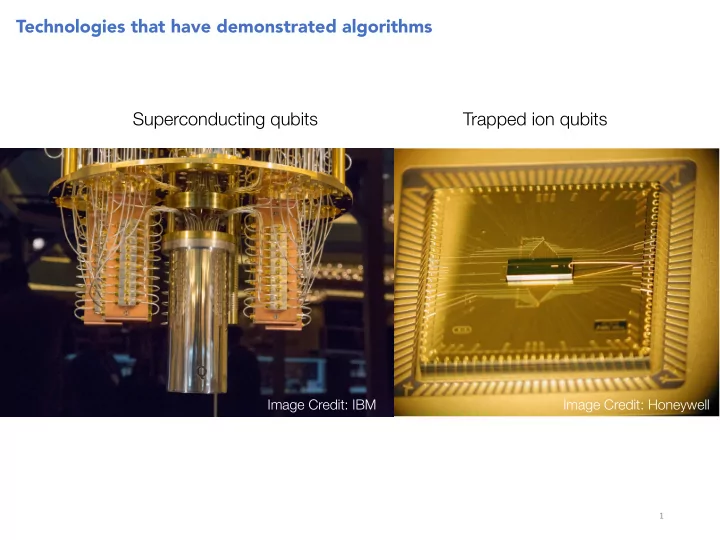

Technologies that have demonstrated algorithms Superconducting qubits Trapped ion qubits Image Credit: IBM Image Credit: Honeywell 1
Surface codes approach with superconducting qubits Image Credit: Google Image Credit: IBM • Approach taken by major industry players: IBM, Google, Rigetti • Internal testing on 72- and 50-qubit machines ongoing, nearest neighbor coupling Image Credit: Honeywell • Demonstrated ~20-qubit machines with all qubits >30us coherence, single Image Credit: Honeywell qubit fidelities around 99.99% and two-qubit gate fidelities near 99% Image Credit: IBM 2 • Entering era where claims of quantum supremacy must be considered
Modular approach with superconducting circuits • Hardware efficient cat-code in each module � Image Credit: Honeywell • Teleport gates between modules � Image Credit: Honeywell • Approach taken by Yale/QCI Image Credit: Yale Image Credit: IBM 3 arXiv:1801.05283
Novel superconducting qubits • Until recently, progress focused on improving dephasing: tranmson qubit � • New focus on fundamental protection from relaxation while maintaining low dephasing Image Credit: Honeywell Phys. Rev. Lett. 120, 150503 (2018) Phys. Rev. A 87, 052306 (2013) Image Credit: Honeywell “zero-pi” device gives relaxation and Inductively shunted transmon gives dephasing times appraoching 10ms relaxation times approaching 10ms in simulation 4 Image Credit: IBM
Application specific quantum computing Image credit: Schuster lab, UChicago arXiv:1802.09549 Simulation of photons in an artificial Image Credit: Honeywell Simulation of a particles on a magnetic field, photonic Weyl Image Credit: Honeywell hyperbolic graph semimetals, and other novel materials Image Credit: IBM Are there near term problems of interest that can be encoded in an ASQC? 5
Challenges and opportunities ahead • Qubit size: high coherence qubits are ~100um in size • Packaging modes cause unwanted crosstalk as size increases • Blend of modular and surface code approaches? � • Cost per channel (qubit) is very high • Is there a way to use classical hardware more efficiently? • Can we find automatic or hardware efficient error corrrecting codes? • Fabrication tolerances and automatic calibration • How do you efficiently tune a large quantum system? • Are there gates that are robust against fabrication disorder? • Are there ways to use something like modelocking to make � qubits identical? Image Credit: Honeywell Image Credit: Honeywell • Is there a useful near-term algorithm? Image Credit: IBM 6
Recommend
More recommend